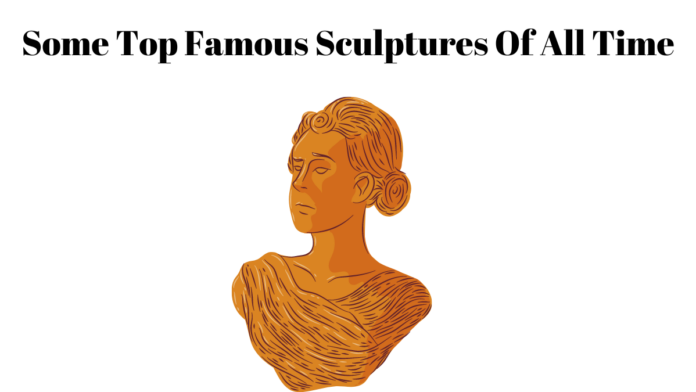Unlike paintings, sculptures are three-dimensional artworks that can be seen from all sides. Some sculptures are large and eye-catching, similar to street art, while others are delicate and require close examination.
In New York City, important sculptures can be found in Central Park, museums like The Met, MoMA, and the Guggenheim, or public outdoor art. These iconic sculptures are easily recognisable, even for casual observers.
From Michaelangelo’s David to Warhol’s Brillo Box, some famous sculptures define their respective eras and the artists who created them. Photos do not capture the true impact of these famous sculptures, so fans should try to see them in person for the full experience.
Venus of Willendorf, 28,000–25,000 BC
This small statue, taller than four inches and found in Austria in 1908, is a mystery in art history. Its purpose is unknown; people have speculated it could be anything from a symbol of fertility to an object used for sexual pleasure. There is also a theory that it might be a woman’s self-portrait. This one is the most well-known among similar artifacts from the Old Stone Age.
Bust of Nefertiti, 1345 C
The famous bust of Nefertiti, made from limestone, represents the queen of Egypt, Nefertiti. It was discovered in 1912 in the Amarna ruins, the capital city of controversial Pharaoh Akhenaten. Nefertiti’s life is shrouded in mystery: Some believe she ruled as Pharaoh after Akhenaten’s death, or perhaps she was the co-regent alongside the young King Tutankhamun.
There is even speculation that she might have been Tutankhamun’s mother. The stucco-coated limestone bust is attributed to Thutmose, Akhenaten’s court sculptor. This ancient masterpiece continues to captivate people as a symbol of beauty and history.
| Sculpture | Artist | Year | Location | Description |
|---|---|---|---|---|
| Bust of Nefertiti | Thutmose | c. 1345 BCE | Neues Museum, Berlin | A limestone and plaster bust of the Egyptian queen, known for its idealized beauty and royal elegance. |
The Terracotta Army, 210–209 BC
Discovered in 1974, the Terracotta Army consists of thousands of life-size clay soldiers, horses, and chariots. These were buried near Shi Huang tomb, the first Emperor of China, who passed away in 210 BC. The purpose of this army was to protect him in the afterlife.
Estimates suggest there are over 8,000 soldiers, 130 chariots, 670 horses. Each figure is life-size, although their actual height varies based on their military rank. The site remains a UNESCO World Heritage Site, even though the inner tomb has not been excavated yet.
Laocoön and His Sons, Second Century BC
The Laocoön and His Sons sculpture, also known as the Laocoön Group, is one of the most famous ancient artworks. It was discovered in Rome in 1506 and is currently displayed in the Vatican Museums. The statue depicts the Trojan priest Laocoön and sons, Thymbraeus, and Antiphantes being attacked by sea serpents. Unlike the redemptive suffering often seen in Christian art, this sculpture portrays pure agony without any reward.
The contorted expressions and strained bodies convey intense suffering. Although attributed to island of Rhodes Greek Sculptures, its exact origin remains uncertain. It likely dates from around 27 BC to 68 AD.
| Sculpture | Artists | Year | Location | Description |
|---|---|---|---|---|
| Laocoön and His Sons | Agesander, Athenodoros, Polydorus | c. 40 BCE | Vatican Museums, Vatican City | A marble sculpture depicting the Trojan priest Laocoön and his sons in agony as they are attacked by serpents. |
Michelangelo, David, 1501-1504
Michelangelo’s David, a masterpiece of Italian Renaissance sculpture, was created between 1501 and 1504. Standing at an impressive 5.17 meters (17 feet), it was the first colossal marble statue made in the early modern period after classical antiquity. Originally commissioned as part of a series of statues for Florence Cathedral’s roofline, it was meant to depict biblical David. However, the statue ended up being placed in a public square in front of the Palazzo della Signoria, Florence’s civic government seat. The Florentine public embraced it as a symbol of their city-state’s resistance against powerful rivals. In 1873, the statue found its home in the Galleria dell’Accademia, while a replica took its place at the original location.
Gian Lorenzo Bernini, Ecstasy of Saint Teresa, 1647–52
The Ecstasy of Saint Teresa, a remarkable sculpture by Gian Lorenzo Bernini, graces the Cornaro Chapel in the Santa Maria della Vittoria church in Rome. Bernini, a leading sculptor of his time, designed not only the sculpture but also the chapel’s marble, stucco, and painted setting. This masterpiece is considered one of the highlights of the High Roman Baroque style.
The sculpture portrays Saint Teresa of Ávila, a Spanish Carmelite nun and mystic. In her moment of religious ecstasy, an angel stands over her, poised to plunge an arrow into the hearts, a vision she had recounted. The sculpture’s dramatic intensity and sensual undertones are evident in the nun’s expression and the flowing fabric that envelops both figures. Bernini’s architectural skills complement his artistic genius, creating a harmonious ensemble that captivates viewers.
Antonio Canova
Antonio Canova, an acclaimed Italian artist from the 18th century, is renowned for his Neo-Classical sculptures. One of his remarkable works is the marble statue of the Greek hero Perseus. Interestingly, Canova created two versions of this piece: one is housed in the Vatican in Rome, and the other stands proudly in the Metropolitan Museum of Art’s European Sculpture Court.
Edgar Degas
Edgar Degas, a famous Impressionist artist, is known primarily for his paintings. However, he also dabbled in sculpture, and one of his most remarkable works is The Little Fourteen-Year-Old Dancer. This famous sculpture was initially made from wax, and later, bronze copies were cast after Degas’s death in 1917. What made it extraordinary was that Degas dressed the young dancer in an actual ballet costume, complete with a bodice, tutu, slippers, and even a wig made of real hair.
When it debuted at the Sixth Impressionist Exhibition in 1881 in Paris, it caused quite a stir. The figure is considered one of the earliest examples of found-object art. Interestingly, Dancer was the only sculpture Degas exhibited during his lifetime, but many more examples were discovered in his studio after his passing.
Auguste Rodin
Auguste Rodin, the renowned French sculptor, is often associated with his famous work The Thinker. However, another ensemble he created holds great significance in the history of famous sculpture. This ensemble, known as The Burghers of Calais, commemorates a critical event during the Hundred Years’ War between Britain and France (1337–1453).
Commissioned for a park in Calais, the Burghers defied the typical monument format of the time. Instead of isolated figures stacked on tall pedestals, Rodin placed his life-size subjects straight on the ground, at eye level with the viewer. The English siege in 1346 was lifted when six town elders volunteered for execution to spare the population.
This departure from convention marked a radical move toward realism, breaking away from the heroic treatment usually seen in outdoor sculptures. The Burghers represent one of the earliest steps toward modern sculpture.
Pablo Picasso
Pablo Picasso, the renowned artist, made a significant impact on 20th-century art with his creation called Guitar. Initially, he crafted a cardboard model in 1912, which later inspired a sheet metal version. Unlike traditional sculptures carved from solid materials, Picasso’s Guitar was assembled like a structure. It broke away from the norm by using flat shapes to form a multifaceted, three-dimensional object.
This innovative approach influenced movements like Cubism, Russian Constructivism, and Minimalism. The snipped tin version followed two years after the cardboard prototype.
Some FAQs
What is a sculpture?
A sculpture is a three-dimensional piece of art, which means it can be viewed from different sides. It’s not flat like a painting.
Can sculptures be big or small?
Yes, sculptures come in all sizes. Some are very large and can be seen from far away, while others are small and must be looked at closely.
Why are some sculptures famous?
Many sculptures are famous because they were made by well-known artists, like Michelangelo’s David. They can also be famous because they show important historical moments or are very old, like the Terracotta Army.















